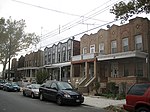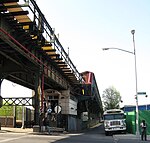Pennsylvania Avenue station (BMT Fulton Street Line)
The Pennsylvania Avenue station was a station on the demolished BMT Fulton Street Line in Brooklyn, New York City. It had 2 tracks and 1 island platform, and was served by trains of the BMT Fulton Street Line. The station was opened on November 18, 1889, one of three other stations to do so. The next stop to the east was Van Siclen Avenue. The next stop to the west was Eastern Parkway, until 1918, when it was replaced by Hinsdale Street.On November 28, 1948, the Independent Subway System built the underground Liberty Avenue Subway station two blocks north after years of war-time construction delays. This station rendered the elevated station obsolete, and it closed on April 26, 1956.
Excerpt from the Wikipedia article Pennsylvania Avenue station (BMT Fulton Street Line) (License: CC BY-SA 3.0, Authors).Pennsylvania Avenue station (BMT Fulton Street Line)
Pennsylvania Avenue, New York Brooklyn
Geographical coordinates (GPS) Address Nearby Places Show on map
Geographical coordinates (GPS)
| Latitude | Longitude |
|---|---|
| N 40.671904 ° | E -73.895861 ° |
Address
Pennsylvania Avenue 236
11207 New York, Brooklyn
New York, United States
Open on Google Maps







